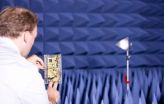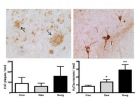(Press-News.org) Scientists from three UK universities have developed a new test to catch drugs-cheats in sport.
Over the last 10 years, the GH-2004 team, which is based the University of Southampton, has been developing a test for Growth Hormone misuse in sport with funding from the World Anti-Doping Agency (WADA) and US Anti-Doping Agency and with support from UK Anti-Doping.
The test, developed by scientists at the University of Southampton, King's College London and University of Kent at Canterbury, is based on the measurement of two proteins in the blood, insulin-like growth factor-I and the amino terminal pro-peptide of type III collagen. Both of these proteins, which act as markers of growth hormone use, increase in response to growth hormone.
The test was used for the first time by King's College London analysts at the anti-doping laboratory for the London 2012 Olympic and Paralympic Games.
On 8 September 2012, the International Paralympic Committee announced that two powerlifters had received two year suspensions for Anti-Doping Rule Violations involving Growth Hormone following an adverse laboratory finding using the new markers test.
The case was a world first as some of the latest testing methods were used which were only introduced prior to London 2012. The new method is able to detect misuse of human growth hormone over a number of weeks, compared to previous methods used which only detected use over a shorter time period.
Richard Holt, Professor in Diabetes and Endocrinology at the University of Southampton and also a consultant in Diabetes at Southampton General Hospital, said, "We are pleased to have another effective and reliable means to catch cheats and help deter harmful drug misuse. There has been a tremendous amount of team work to develop this test and I am delighted that this dedication has finally succeeded. I would like to thank the World Anti-Doping Agency, US Anti-Doping and UK Anti-Doping for their support and trust in our work."
Professor David Cowan, Head of the Drug Control Centre at King's College London and Director of the anti-doping laboratory for the Games, said: "These findings prove that the years of research have been worthwhile. In partnership with the University of Southampton and Kent University, this has been one of the most complex scientific projects the Drug Control Centre at King's has been involved in. To be able to carry out this test at this year's Games is a huge achievement. It represents a big step forward in staying at the forefront of anti-doping science, to help deter drug misuse in sport."
Andy Parkinson, UK Anti-Doping Chief Executive, adds: "Continual improvement in testing science is fundamental to the global anti-doping movement, ensuring that sophisticated dopers are caught and those at a tipping point are deterred. I am delighted that this UK developed test, which my team has been closely involved with, was used at the 2012 Paralympic Games to such good effect."
WADA President John Fahey praised the test by saying: "The new test – which has been approved by WADA – was first introduced prior to the London 2012 Olympic Games, and we are confident that it will prove a significant tool in the fight against doping in sport.
"It will complement the test that has been in use since the 2004 Athens Olympic Games, the major difference being that the anti-doping community now has a much longer detection window to work with."
### END
New test to crack down on sporting drugs-cheat test
2012-09-14
ELSE PRESS RELEASES FROM THIS DATE:
Researchers find our inner reptile hearts
2012-09-14
Since the early 1900s, scientists have been wondering how birds and mammals could have developed almost identical conduction systems independently of each other when their common ancestor was a cold-blooded reptile with a sponge-like inner heart that has virtually no conduction bundles.
The studies show that it is simply the spongy inner tissue in the foetal heart that gets stretched out to become a fine network of conductive tissue in adult birds and mammals. And this knowledge can be put to use in the future.
### END ...
Environment: Speaking the same language on noise exposure
2012-09-14
Quantifying noise exposure will be significantly easier thanks to a new set of common noise assessment methods published today. Comparable data on noise exposure in Europe is a prerequisite to set up EU policies to reduce noise pollution, a growing health and economic concern all over Europe. The new methods – known as Common Noise Assessment Methods in Europe (CNOSSOS-EU) – were drawn up by the European Commission's in-house science service, the Joint Research Centre. They assess noise from road, rail and air traffic and from industry, and will provide consistent and comparable ...
X-rays reveal the self-defence mechanisms of bacteria
2012-09-14
Many pathogenic bacteria are able to go into a dormant state by producing persister cells that are not susceptible to conventional antibiotics. This causes serious problems in the treatment of life-threatening diseases such as tuberculosis, where the presence of persister cells often leads to a resurgence of infection following medical treatment.
At the molecular level, the formation of persister cells is due to the presence of toxins that are produced by the bacteria themselves, and which enable them to enter the dormant state. During this hibernation period, the bacteria ...
Radar measurements of highest precision
2012-09-14
This press release is available in German.
Precise determination of distances is of increasing importance in fabrication technology, for instance, when actuating robots, producing micromechanical components, or controlling machine tools. Frequently, glass scales, inductive sensors, or laser measurement systems are used for distance measurements. Glass scales are very precise and reach micrometer precision. However, they are too inflexible and expensive for daily use. Inductive sensors measuring distances with a coil, magnetic field, and movement work in a contact-free ...
Passive smoking also affects neurodevelopment in babies
2012-09-14
A new study shows that newborns that have been exposed to nicotine from both active and passive smoking mothers show poor physiological, sensory, motor and attention responses.
Smoking during pregnancy has been linked to many different problems in infants like learning difficulties, attention deficit disorder with hyperactivity and even obesity.
However, although the paediatric and obstetric disorders linked to tobacco during this stage are well defined, the effects on neonatal behaviour have not yet been studied in depth.
A new study headed by experts at the ...
New insights on cell competition
2012-09-14
Scientists from the Spanish National Cancer Research Centre (CNIO) describe how natural selection also occurs at the cellular level, and how our body's tissues and organs strive to retain the best cells in their ranks in order to fend off disease processes. These results appear this week in the new issue of Cell Reports. The research, carried out in the CNIO, is led by Eduardo Moreno, who is currently working at the University of Bern in Switzerland.
Recent studies suggest that natural selection described by Charles Darwin also occurs at the cellular level, as our body's ...
Trade unions still fail to lure women leaders, study finds
2012-09-14
There is little doubt that Frances O'Grady has made history as the first woman to be elected General Secretary of the Trades Union Congress in September 2012. A recent study from Queen Mary, University of London casts some light on the level of O'Grady's achievement in the wider union landscape.
This cross-national study found that in both the UK and the US, women still have fewer top positions in trade unions despite growth in overall female membership.
The paper, Lift as You Rise: Union Women's Leadership Talk, discusses the lack of women at union leadership level, ...
Getting (drugs) under your skin
2012-09-14
CAMBRIDGE, MA -- Using ultrasound waves, MIT engineers have found a way to enhance the permeability of skin to drugs, making transdermal drug delivery more efficient. This technology could pave the way for noninvasive drug delivery or needle-free vaccinations, according to the researchers.
"This could be used for topical drugs such as steroids — cortisol, for example — systemic drugs and proteins such as insulin, as well as antigens for vaccination, among many other things," says Carl Schoellhammer, an MIT graduate student in chemical engineering and one of the lead authors ...
Surgery more profound effect than anesthesia on brain pathology, cognition in Alzheimer's mice
2012-09-14
PHILADELPHIA — A syndrome called "post-operative cognitive decline" has been coined to refer to the commonly reported loss of cognitive abilities, usually in older adults, in the days to weeks after surgery. In fact, some patients time the onset of their Alzheimer's disease symptoms from a surgical procedure. Exactly how the trio of anesthesia, surgery, and dementia interact is clinically inconclusive, yet of great concern to patients, their families and physicians.
A year ago, researchers at the Perelman School of Medicine at the University of Pennsylvania reported ...
45 percent of layoff victims, despite anger, would return to former employer
2012-09-14
With an 8.1 percent August unemployment rate and 12.5 million Americans out of work, a new Temple University study examines a neglected area of research: how the unemployment process impacts the willingness of those laid off to endorse or return to their previous employer.
The study of predominantly highly paid, college-educated professionals who are unemployed finds that 45 percent of layoff victims would return to work for their former employer – despite anger over being terminated. The research also emphasizes the importance of fair and transparent layoff decisions, ...


